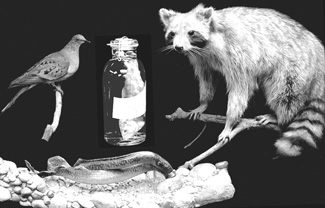The University Record, April 8, 1998
By John Klausmeyer
Exhibit Museum
|
|
|
New exhibits at the Exhibit Museum will help explain the effect humans have on natural habitat and animals that live in the state’s wildlands. Photo courtesy Exhibit Museum |
What have humans done to Michigan? What happens when human needs and activities collide with the natural world? Answers to these questions can be found in the new exhibits under development in the Exhibit Museum’s third-floor Michigan Wildlife Gallery.
In the worst case scenario, a formerly abundant native species is driven to extinction, usually through a combination of commercial over-harvesting, environmental degradation and habitat loss. The passenger pigeon is a classic and tragic example.
In the early 1800s, the passenger pigeon was Earth’s most abundant land bird, numbering more than three billion. During migration and breeding seasons, vast flocks blackened the skies of eastern North America. In the 19th century, the passenger pigeon was considered an unlimited resource and millions were killed each year. Habitat destruction also played a role in the decline, especially deforestation of nesting grounds. Hunting stopped by the early 1900s, but the species’ numbers continued to drop. The last official Michigan sighting was in 1896, and the last passenger pigeon died in the Cincinnati Zoo in 1914.
The accidental or planned introduction of “exotic” species into an ecosystem is another way in which human intervention has wreaked environmental havoc. The sea lamprey is an example. A native of the Atlantic Ocean, it has invaded the Great Lakes, attaching itself to other fish with a sucking disk-shaped mouth full of sharp, rasping teeth, feeding on the host’s blood and other bodily fluids, often scaring and killing the host fish. During the 19th and early 20th centuries, the lamprey spread through shipping canals into the Great Lakes, its population booming at the expense of many fish native to the western Great Lakes. The ecosystem was devastated. No natural predators for the lamprey have been found. Sea lamprey control has been the single most expensive conservation project in history.
There are, however, opportunistic plant and animal species that actually benefit from the presence of modern human civilization. They are able to take advantage of changes humans have made to the environment, sometimes becoming so numerous that they become a nuisance. The raccoon is a well-known example of opportunistic urban wildlife. Raccoons usually live in wooded areas and build their dens in hollow trees. Active mainly at night, they are notorious for rooting through garbage as they forage for food.
In some instances, the specimens in the new exhibits speak with silent eloquence, such as the poignant image of the extinct deepwater cisco floating in a jar of preserving alcohol. Were it not for over-harvesting by commercial fisheries and the onslaught of the sea lamprey, this species would still be sharing the planet with us. The exhibits demonstrate how the natural world serves as our life support system, providing countless medical, agricultural and commercial benefits. Every time a species becomes extinct, an irreplaceable resource is lost.
Completion of the exhibits is scheduled for fall. Admission to the Exhibit Museum is free. It is open 9 a.m.-5 p.m. Monday-Saturday and 1-5 p.m. Sunday 1-5 p.m.. and closed major holidays. The Museum’s Web page is at http://www.exhibits.lsa.umich.edu/.


